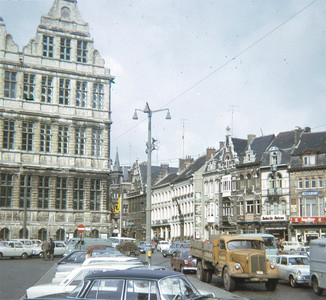BOXES 28-30: Belgium.
- Joe Milicia
- Dec 10, 2020
- 4 min read
Updated: Apr 11, 2021

I'm hardly the first person to find the city of Bruges one of the most enchanting places I've ever visited. Providing historical information is not the goal of this blog, but I do want to point out that in medieval and early Renaissance times Bruges was a very wealthy port city whose revenue dried up as its waterway to the sea silted up, leaving it "high and dry" except for its remaining canals and ponds. (I'm using the French name, as English-speakers usually do, though the town is completely within Flemish-speaking Belgium and known locally as Brugge, with the "gg" pronounced as a strong "h".) Bruges wasn't exactly preserved in amber, but it was seriously neglected until travelers and tourists "discovered" it in the late 19th Century with its medieval buildings and narrow streets relatively untouched.
As I mentioned in the previous blog, I took a ferry from Dover to get to the Belgian coast. It left in the late afternoon, and the weather, cloudy already, started getting pretty chilly and threatening a storm. This was not a happy prospect for second-class travelers like myself, because we were assigned to the open decks--no reserved seat inside. I struck up a conversation with a young American couple in the same situation, and we discovered that we could be seated indoors at the restaurant--and maybe we could stretch dinner to last most of the 3-hour voyage. This worked out very well for us. As it turned out, the dining hall remained empty except for us and one young Dutch woman who joined our table: the sea was getting very rough, and evidently no one else had an appetite. The evening special was a hearty stew, and soon after being served, the Dutch girl turned pale and fled the table, not returning. Somehow the American couple and I didn't get seasick--we enjoyed both the stew and our conversation, despite the ship swaying up and down. (Today I would be terrified that the ship might capsize, but then I guess I just assumed that that was what a ferry ride was like.)
When we finally landed and I took the short train ride from Ostend to Bruges, it was night and pouring rain--and in Bruges the station is quite some distance from the old town. But a kindly local couple saw me standing, umbrellaless, wondering what to do about a hotel, and offered me a ride in their car. They dropped me off at a promising hotel right in the city center, and I got a room.
The next morning, the rain was lighter. I bought an umbrella for my first walk around the city. Most of the slide photos I took that morning look dim but poetic when projected, and just plain dim when digitized, but here they are as a record of my first morning in Bruges:
The next day was sunnier, and I got a few decent pictures, like the one posted at the top. Here are a few others, including a couple from a windmill at the edge of the old town:


At the Church of Our Lady one can find the only Michelangelo sculpture outside of Italy, a Madonna and Child purchased in 1504 by wealthy Bruges merchants:
One day I took a side trip from Bruges to Ghent, a short distance eastward (here's a photo from the train window). I went for two reasons beyond the fact that Ghent was supposed

to have many historic buildings of interest: first, to see the famous Adoration of the Mystic Lamb altarpiece by Jan van Eyck, and second, to attend a concert (in the Cathedral, where the altarpiece was also to be found) of Bruckner's Eighth Symphony with the visiting Concertgebouw Orchestra led by Bernard Haitink. I didn't get pictures of either the painting or the orchestra, or even a close-up of the Cathedral, though when I went to a nearby restaurant for a pre-concert supper of waterzooi, the Flemish chicken or fish stew, the place was mostly filled with Concertgebouw players in their white ties and tails. But during the afternoon I did take a number of photos of the historic guildhouses with their distinctive Flemish gables, plus the turrets of a gatehouse and the world's most ornate 5-minute car wash:


I also visited the Castle of the Counts of Flanders (aka the Gravensteen), now a museum. I found the structure a bit creepy (because of what I'd read about its sometimes violent history, and because of its dirt-encrusted stone). But it provided grand views of the city from its parapets.
In the late afternoon of my second day in Bruges I took the train to Brussels, there to transfer to an overnight train to Rome, my next planned stop. It turned out that there was a long walk between Brussels train stations, or maybe I wanted to walk instead of taking a rail connection because I had just enough time to make a quick stop at Brussels' most famous locale, the Grand Place, and take one photo of one building, the City Museum across the square from the Town Hall; plus one other photo as I walked toward the central train station:
From there it was overnight through the Alps and a long morning and afternoon down through Italy to Rome--the subject of my next post.


















































Comments